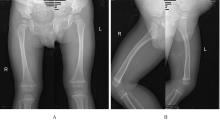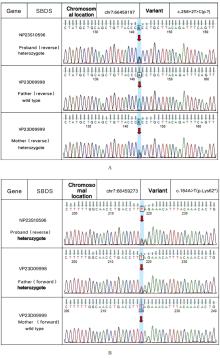| 1 |
NEZELOF C, WATCHI M. Lipomatous congenital hypoplasia of the exocrine pancreas in children. (2 cases and review of the literature)[J]. Arch Fr Pediatr, 1961, 18: 1135-1172.
|
| 2 |
MERCURI A, CANNATA E, PERBELLINI O, et al. Immunophenotypic analysis of hematopoiesis in patients suffering from Shwachman-Bodian-Diamond Syndrome[J]. Eur J Haematol, 2015, 95(4): 308-315.
|
| 3 |
HALL G W, DALE P, DODGE J A. Shwachman-Diamond syndrome: UK perspective[J]. Arch Dis Child, 2006, 91(6): 521-524.
|
| 4 |
HUANG J N, SHIMAMURA A. Clinical spectrum and molecular pathophysiology of Shwachman-Diamond syndrome[J]. Curr Opin Hematol, 2011, 18(1): 30-35.
|
| 5 |
MINELLI A, NICOLIS E, CANNIOTO Z, et al. Incidence of Shwachman-Diamond syndrome[J]. Pediatr Blood Cancer, 2012, 59(7): 1334-1335.
|
| 6 |
GIJSBERS A, GARCÍA-MÁRQUEZ A, LUVIANO A, et al. Guanine nucleotide GIJSBERS A, GARCÍA-MÁRQUEZ A, LUVIANO A,et al. Guanine nucleotide exchange in the ribosomal GTPase EFL1 is modulated by the protein mutated in the Shwachman-Diamond syndrome[J]. Biochem Biophys Res Commun, 2013, 437(3): 349-354.
|
| 7 |
CALAMITA P, MILUZIO A, RUSSO A, et al. SBDS-Deficient cells have an altered homeostatic equilibrium due to translational inefficiency which explains their reduced fitness and provides a logical framework for intervention[J]. PLoS Genet, 2017, 13(1): e1006552.
|
| 8 |
TOURLAKIS M E, ZHANG S Y, BALL H L, et al. In vivo senescence in the sbds-deficient murine pancreas: cell-type specific consequences of translation insufficiency[J]. PLoS Genet, 2015, 11(6): e1005288.
|
| 9 |
SPINETTI E, DELRE P, SAVIANO M, et al. A comparative molecular dynamics study of selected point mutations in the shwachman-bodian-diamond syndrome protein SBDS[J]. Int J Mol Sci, 2022, 23(14): 7938.
|
| 10 |
NELSON A S, MYERS K C. Diagnosis, treatment, and molecular pathology of shwachman-diamond syndrome[J]. Hematol Oncol Clin North Am, 2018, 32(4): 687-700.
|
| 11 |
CARAPITO R, KONANTZ M, PAILLARD C, et al. Mutations in signal recognition particle SRP54 cause syndromic neutropenia with Shwachman-Diamond-like features[J]. J Clin Invest, 2017, 127(11): 4090-4103.
|
| 12 |
刘俊丽, 史宝海, 姚 国, 等. Shwachman-Diamond综合征1例报告[J]. 中国实用儿科杂志, 2017, 32(11): 878-880.
|
| 13 |
GANA S, SAINATI L, FRAU M R, et al. Shwachman-Diamond syndrome and type 1 diabetes mellitus: more than a chance association?[J]. Exp Clin Endocrinol Diabetes, 2011, 119(10): 610-612.
|
| 14 |
BEZZERRI V, CIPOLLI M. Shwachman-diamond syndrome: molecular mechanisms and current perspectives[J]. Mol Diagn Ther, 2019, 23(2): 281-290.
|
| 15 |
VALLI R, FRATTINI A, MINELLI A. Shwachman-Diamond syndrome: diagnosis, pathogenesis and prognosis[J]. Expert Opin Orphan Drugs, 2017, 5(10): 753-767.
|
| 16 |
GINZBERG H, SHIN J, ELLIS L, et al. Shwachman syndrome: phenotypic manifestations of sibling sets and isolated cases in a large patient cohort are similar[J]. J Pediatr, 1999, 135(1): 81-88.
|
| 17 |
GRINSPAN Z M, PIKORA C A. Infections in patients with Shwachman-Diamond syndrome[J]. Pediatr Infect Dis J, 2005, 24(2): 179-181.
|
| 18 |
DONADIEU J, LEBLANC T, MEUNIER B B, et al. Analysis of risk factors for myelodysplasias, leukemias and death from infection among patients with congenital neutropenia. Experience of the French Severe Chronic Neutropenia Study Group[J]. Haematologica, 2005, 90(1): 45-53.
|
| 19 |
FURUTANI E, LIU S S, GALVIN A, et al. Hematologic complications with age in Shwachman-Diamond syndrome[J]. Blood Adv, 2022, 6(1): 297-306.
|
| 20 |
CESARO S, PEGORARO A, SAINATI L, et al. A prospective study of hematologic complications and long-term survival of Italian patients affected by shwachman-diamond syndrome[J]. J Pediatr, 2020, 219: 196-201.
|
| 21 |
MYERS K C, BOLYARD A A, OTTO B, et al. Variable clinical presentation of Shwachman-Diamond syndrome: update from the North American Shwachman-Diamond Syndrome Registry[J]. J Pediatr, 2014, 164(4): 866-870.
|
| 22 |
HO W, CHERETAKIS C, DURIE P, et al. Prevalence of oral diseases in Shwachman-Diamond syndrome[J]. Spec Care Dentist, 2007, 27(2): 52-58.
|
| 23 |
RUGGERO D, SHIMAMURA A. Marrow failure: a window int o ribosome biology[J]. Blood, 2014, 124(18): 2784-2792.
|
| 24 |
BARıŞ Z, ÖZÇAY F, OLCAY L, et al. A case of shwachman-diamond syndrome who presented with hypotonia[J]. J Pediatr Genet, 2018, 7(3): 117-121.
|
| 25 |
PEROBELLI S, ALESSANDRINI F, ZOCCATELLI G, et al. Diffuse alterations in grey and white matter associated with cognitive impairment in Shwachman-Diamond syndrome: evidence from a multimodal approach[J]. Neuroimage Clin, 2015, 7: 721-731.
|
| 26 |
VIBHAKAR R, RADHI M, RUMELHART S, et al. Successful unrelated umbilical cord blood transplantation in children with Shwachman-Diamond syndrome[J]. Bone Marrow Transplant, 2005, 36(10): 855-861.
|
 )
)







